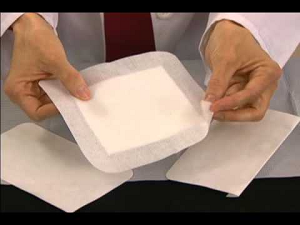
Composite Wound Dressings
They are wound covers that combine physically distinct components into a single product to provide multiple functions, such as a bacterial barrier, absorption, and adhesion. Usually, they are composed of multiple layers and incorporate a semi- or non-adherent pad that covers the wound. May also include an adhesive border of non-woven fabric tape or transparent film. Composite dressings can function as either a primary or a secondary dressing on a wide variety of wounds and may be used with topical medications.
Demonstration Videos
SPECIFICATIONS
3 Tips for Choosing the Best Wound Dressings

There are several ideas to keep in mind when choosing wound dressings. If you’ve ever spoken with your doctor, or even browsed through your local…
There are several ideas to keep in mind when choosing wound dressings.
If you’ve ever spoken with your doctor, or even browsed through your local medical supply store, you might already be aware of the options patients have for wound dressings. With so much variety available, including different styles, core materials and basic usage, it can be difficult to choose the right dressing for your unique wound healing needs. If you find yourself stuck seeking out the best option, follow these handy tips for choosing the best dressing:
1. Know your types
While there is an abundance of wound dressing types available, not every dressing might be suitable for your treatment plan. There are basically four dressing types most patients use, and each one works with a handful of wounds. Hydrocolloid is best for burns, venous ulcers and as a support with compression wraps. Alginate, meanwhile, is ideal for wounds with excess drainage, or stage III or IV pressure ulcers. Hydrogel is your best bet for wounds without a lot of excess fluid, like those that are infected or already necrotic. Finally, you want to go for collage dressings if you’re dealing with bed sores, chronic wounds or transplant sites.
2. Know what not to use
If you’re having problems selecting your wound dressing, it may help to follow the Royal Pharmaceutical Society: Eliminate options you know will impede wound healing. There is a myriad of options, from cleansers to ointments that will do more harm than good. For instance, anything with sodium hypochlorite will actually damage the capillaries and surrounding cells. Topical antibiotics will only increase the resistance capability of some bacterial strains. Even some topical desloughing agents contain streptokinase, which can lead to a loss of sensation. Sometimes knowing what to avoid makes the right options come into focus.
3. Know what you’re talking about
If you were buying a car, you’d spend some time researching the various models, deciding what you want and then picking a car that has everything you want for the best price. The same techniques should apply to how you choose wound dressings, and that means doing as much research as possible. Read plenty of FAQ lists and case studies: These are great resources to help you understand what goes into diagnosing and treating wounds. You can also read studies; For instance, a 2014 review published in the Advances in Wound Care outlines offers insight into the best characteristics of wound dressings. Even your doctor or caregiver is a great source of information, as he or she can tackle concepts as they apply to you directly.
Advanced Tissue is the nation’s leader in specialized wound care supplies, delivering to both homes and long-term care facilities.
Please note: blog posts are rarely updated after the original post. Because the medical industry is ever changing; please make certain to reference the current product list as well as up-to-date industry information when considering product selection or treatment. Always consult a physician to discuss specific concerns or questions related to your health.
RELATED ITEMS
My Wound Doctor
MyWoundDoctor Home-based, health care consumers – patients – frequently suffer from hard-to-heal Read more...
Prospera Wound Vac Instructions
Prospera PRO series negative pressure wound care The negative pressure wound therapy Read more...
Medela (Invia) Liberty Instructions
Invia Liberty Wound Care – Medela The Invia Liberty delivers Read more...
Invia Motion Negative Pressure Wound Therapy
Invia Motion Negative Pressure Wound Therapy The pump provides the convenience of a personal Read more...
KCI NPWT System | V.A.C.Ulta Application
KCI NPWT System | V.A.C.Ulta Application Designed for use with trusted V.A.C.® Read more...
V.A.C.Via™ Negative Pressure Wound Therapy
V.A.C.Via™ Therapy Device A mobile, ultra-portable, single patient use, disposable V.A.C.® Therapy Device Read more...
Interactive Wound Dressings Instructions
Interactive Wound Dressings The ideal dressing material should provide a moist environment Read more...
Sterile Dressing Wound Care Change Instructions
Follow these steps to remove your dressing: Wash your hands thoroughly Read more...
Hydrocolloid Wound Dressings Instructions
Hydrocolloid dressing They are easy to apply to the wound and come Read more...
Foam Wound Dressings Instructions
Composite Wound Dressings They are wound covers that combine physically distinct Read more...
 PATIENT LEARNING CENTER
PATIENT LEARNING CENTER

